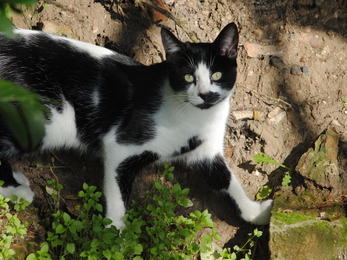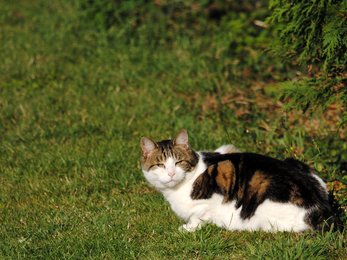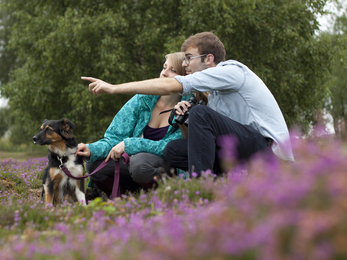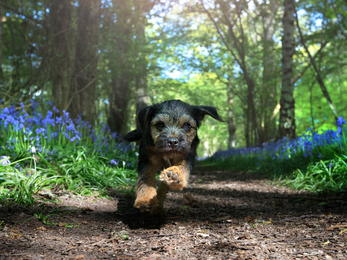We are often referred to as a nation of pet lovers. Our furry friends provide companionship and help us relax, they can comfort us when we need reassurance and they can help us to connect with other people. Many people love wildlife just as much as their pets, and in this blog we aim to help cat and dog owners do ‘just one thing’ to help nature and the environment.
Take action for wildlife: February
Cat owners
That soft bundle of fur, purring soothingly on your lap couldn’t hurt a fly, could it? Well, yes probably! All cats have a hunting instinct. They are intelligent, athletic, and very efficient predators.
Birds might be the first thing you think about when considering potential prey. Indeed, nestlings and young fledglings are easily caught as they haven’t developed their flight feathers or learnt how to escape danger.
Other creatures at risk include small mammals. Although many people may welcome some ‘natural control’ of uninvited house guests such as mice and rats, cats can have more ‘exotic’ tastes. With exceptional paw-eye coordination, cats are agile enough to grab bats as they emerge from daytime roosts, sitting on the roof and snatching them as they fly out.
Depending on what is in your cat's territory, froglets, newts and lizards may also be on the menu.
So, what simple things can we do to reduce the impact of our fabulous feline friends?
- Keep your cat indoors at night - Darkness is a good cloak for hunting, so call your cat in before dusk to help protect roosting birds, bats and other species.
- Dress to impress - Fitting your feline with a colourful collar and bell will alert wildlife to approaching danger and help enable a timely escape.
- Prickly plants - Deter cats from finding nests by having one or two prickly garden shrubs. A few sprigs of holly by bird feeders or nest boxes can also do the trick.
- Above and beyond - Site bird boxes where they can’t be reached by curious cats.
- Play time - A piece of paper tied to string (or other toy) can simulate hunting behaviour and reduce wildlife impacts. Research by ‘songbird-survival uk’ revealed that 5-10 minutes of playtime reduced the amount of prey caught by 25%!
- Eat well - In the same study, providing food rich in meat protein was also found to reduce bird predation.
Dog owners
OK, so cats are one thing, but surely ‘man’s best friend’ can’t be a threat to wildlife? Dogs have great conservation credentials and can even be trained to survey for great crested newts! Our pampered pouches, however, can have some surprising impacts on local wildlife.
You might not think birds are at risk from dogs, but some overwintering birds spend a lot of time feeding on the ground (e.g. lapwing, redwing and starlings) or in shallow water (e.g. waders such as sanderling, oystercatchers and turnstones). During the breeding season some birds prefer to nest on, or low to, the ground (e.g. nightjar, skylark and Dartford warbler). Dogs off the lead can scare and disturb them, reducing the time spent feeding and causing nests to be abandoned, exposing vulnerable eggs and chicks.
Fleas, ticks and parasites are annoying for dogs and us, but the chemicals used in spot treatments for these, and other parasites, can cause harm to creatures living in our streams, rivers and ponds. Tiny amounts of these chemicals are incredibly toxic to aquatic life. More research is needed into the impacts of flea treatments, but the British Veterinary Association advice is to avoid ‘blanket’ application. It has been suggested that tablets are less likely to cause harm, but, again, more research is needed. There is some useful information on the BVA website as well as tips 'to help keep pets, people and the planet safe.'
Finally, and probably one with the most obvious impacts – dog poo! Please pick up after your dog, it’s not only a health risk to humans, pets and wildlife but it can be an unwelcome source of nutrients in delicate habitats.
So, what simple things can we do as dog owners to look after wildlife?
- Dogs on leads - Please follow guidelines when visiting nature reserves or other greenspaces.
-
Swimming at SANGs - ‘Suitable Alternative Natural Greenspaces’ are great places to exercise your dog. If they like to swim, look out for SANGs which have dedicated freshwater ponds or dog dips, as these will help reduce erosion on riverbanks.
-
Pond life – Please minimise disturbance to these fantastic wildlife habitats – ‘Buster & Molly’ have some top tips!
-
Flea treatments - Minimise risks to the environment and chat to your vet about treatment options. Check the instructions before you wash your pet or let your dog go for a swim.
-
Pick up poop – Reduce the spread of disease, by picking up and disposing of dog poo responsibly. Biodegradable, plastic-free poo bags are available.
Please check out the Dorset Dogs website and the ‘Doggy Do Code’ for lots of top tips.
So whether you are a cat or a dog lover (or both), please consider whether you can do 'just one thing' to protect wildlife.














